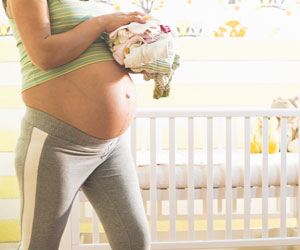Whether you’re a Sierra Club card carrying vegetarian or don’t think twice about throwing plastic bottles in the trash, there’s nothing like being pregnant to make you want to live a more environmentally conscious life. The nursery is one place where your eco-friendly intentions and action can converge. With a few smart choices, you can create a healthy home environment for your little one. For ideas on how you can choose to green baby’s space and create an eco-friendly nursery, Heather Stephenson, co-founder of the green living website Ideal Bite has these helpful tips.
Paint
“Absolutely don’t use regular paint in the nursery,” Stephenson warns. Paints are full of toxins and chemicals affect children’s bodies differently than adults’. No-VOC formulas, which contain fewer unhealthy volatile organic compounds, are now available in many great colors for the nursery from both established and newer paint brands.
Flooring
When it comes to flooring, virtually anything is better than carpet, which is typically synthetic and hard to clean. “They’re going to be crawling, they’re going to be scooting, they’re going to be lying down and playing,” Stephenson reminds. So instead of carpeting, consider heavy-duty, renewable alternatives like cork, topped with a rug that’s easily cleaned or replaced.
Cribs
“Look for a hardwood crib with low-VOC finishes,” Stephenson says. Unlike medium- density fiberboard or other composite materials, hardwood furniture doesn’t need toxic epoxies to stay in one piece. And a finish with fewer VOCs means fewer chemicals overall. For the most value, don’t consider any crib that doesn’t also become a toddler bed, at the very least.
Mattresses
“Mattresses are complicated,” Stephenson says. The culprit? Government regulations mean manufacturers have to add chemicals to make many fabrics inflammable. But these ingredients are known to cause headaches and other allergic reactions. Fortunately, the wool and natural latex making up today’s newer mattresses are flame-retardant on their own, or use natural treatments to help them pass rigid safety tests.
Bedding
“This is where you can really focus on the planet,” Stephenson says. “It’s good to have non-pesticide cotton next to your baby’s skin, yes, but it’s also one of the best things you can do environmentally.” Twenty-five percent of the world’s pesticides are used to help raise conventional cotton. Choose organic instead—these days, even mainstream companies are making it available.
Toys
Watching baby play with toys will make you cringe if you don’t feel safe about what they’re made of. Before you buy, remember she’ll chew on them and rub them in her face. “Switch from soft plastics to natural wood and fabric toys made with organic cotton,” Stephenson says. “You’ll feel better.”
Cleaning products
“Make sure that you’re cleaning your whole house with natural cleaning products,” Stephenson says. “Don’t just focus on the nursery.” Before you know it, baby will be everywhere, and you don’t want to worry about how you’ve cleaned the floor just as she’s crawling all over. To save dough and clean greenly, use basics like white vinegar.
Indoor air
Following this article’s advice will go a long way toward improving the air baby breathes at home, but Stephenson has one more tip: “Get a plant for every 10 square feet of your house.” There are good air filters out there, but research shows they aren’t much more effective than the natural solution, according to Stephenson. To mask odors, go with essential oil–based products rather than perfumed fresheners.
